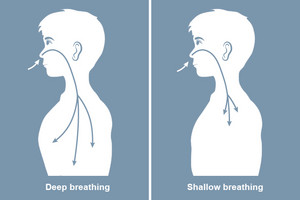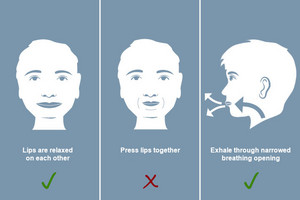Is your child coughing all the time and hardly able to stop? Help your child learn how to control the urge to cough, to ease the cough and to cough properly. We have some tips from the respiratory physiotherapist Marlies Ziegler.

There are a few home remedies and breathing techniques to ease the urge to cough and mitigate coughing fits in your child.
Generally speaking, if your child is coughing violently and continuously for a long time, you should urgently see a paediatrician to find out why this is happening.
If your child is coughing because of an infection – like a cold or the flu – you can ease their cough with the following home remedies.
It ensures that the mucous membranes in the bronchial tubes are moist. The drier the mucous membranes, the higher the risk of having to cough. So your child should drink regularly – ideally still water or unsweetened herbal or fruit tea.
A teaspoon of onion syrup with honey several times a day (for children from twelve months of age) can also ease the urge to cough. The essential oils and the anti-inflammatory compounds in the onion and the honey make this syrup really effective against coughs, including dry coughs.
Firstly, heat on the chest relaxes the muscles in the chest which have a tendency to become tense with vigorous and frequent coughing fits. Secondly, the heat has a calming effect and stimulates blood circulation. This makes it easier to shift thick and persistent mucus, which may be responsible for the urge to cough. Warm wraps can provide this soothing heat. Alternatively, cover your child’s chest in a damp, warm towel and place a hot water bottle on top.
NB: Do not use heat treatment if your child has a fever.

Just as drinking ensures that the mucous membranes remain moist, inhalation therapy with an inhalation device such as the PARI BOY moistens your child’s airways. The inhalation device with a nebuliser delivers inhalation solutions with salt into the bronchial tubes. The dispersed saline solution moistens the child’s airways and naturally loosens the mucus.
In detail: Isotonic saline solution hydrates, conditions and calms the mucous membranes, which leads to less irritation. If the cough is triggered by firmly lodged mucus, inhaling hypertonic saline solution can liquefy and loosen the mucus. The mucus can then be brought up with less effort if your child coughs briefly or clears their throat.
Encourage your child to pay close attention to themselves and their urge to cough. How quickly does the urge develop? Are there warning signs? Does the urge to cough sometimes go away again? Does it start off as a little cough that then builds up into a proper cough and then a full-blown coughing fit? Does your child feel that there is anything that can alleviate the urge to cough?
By self-monitoring and being aware of how their body reacts, your child can then consciously use simple breathing techniques to control a cough. Even if it sounds unimaginable, with a little practice you can suppress the urge to cough and control coughing fits.
Usually, when you have a cough your reflex is to breathe in through your mouth. But breathing in fast through your mouth irritates the airways in several ways. This is because:
This is why breathing through your mouth can make your cough even worse. Try to sensitise your child to breathe in through their nose before coughing if they can. Often, the urge changes and the cough can be suppressed or even avoided.

When coughing, external forces act on the bronchial tubes, which can tire and collapse with frequent coughing fits. That can cause more coughing, that may be almost impossible to stop. To avoid that, your child should cough with their mouth closed.
The closed mouth forms a resistance that diffuses the blast of air. The bronchial tubes respond with less irritation and are protected. If the pressure is too great and the cough bursts out of the child and they cannot keep their mouth closed, external forms of resistance may help.

As soon as your child can feel pressure building up in their lungs and they feel the urge to cough, they should try to hold their breath – ideally, until the urge to cough eases off. After holding their breath, they should take careful and shallow breaths so that the urge to cough does not return.
Diese Atemtechnik erfordert etwas Übung und klappt nicht direkt beim ersten Versuch. Manchmal ist der Hustenreiz auch zu groß, als dass man diesen unterdrücken könnte. Aber einen Versuch ist es immer wert.

A useful technique to slow down the flow of air and to protect the bronchial tubes from collapse and coughing is the pursed lip technique. Here, your child breathes out through loosely closed lips. Here are precise instructions on pursed lip breathing.

“Huffing” involves puffing away the urge to cough instead of coughing. Your child can use this technique especially if they have mucus or other obstructions in their windpipe. Here are detailed instructions on the huffing technique. Huffing is a matter of practice.
There are also many other breathing techniques that can bring coughing under control. Physiotherapists can help identify and teach methods that best suit your child.
Coughing is a natural reflex that clears and protects the airways. It happens if foreign bodies or micro-organisms have to be removed from the bronchial tubes. Infections in the airways can lead to thick mucus being produced which is difficult to transport away and which triggers a cough.
So, as a basic principle, coughing is not something bad or serious. But, as is usually the case, the dose makes the poison. Coughing too much and too forcefully is bad for two reasons:
When we cough, it is like a high-impact sport for the body. We use all kinds of muscles when we cough. That uses up calories and drains us of energy. So persistent and uninterrupted coughing can weaken and tire your child. Because of the high pressure that is built up in their body when your child coughs, they may also get a headache and briefly feel slightly dizzy.
The pressure from the coughing may even be as high as to cause small blood vessels in the eyes to burst. This is why it is important that your child learns to control the urge to cough and to cough properly, i.e. in a way that does not cause harm.
If a child is constantly coughing over a long period of time, it can become a kind of habit, like a tick. Your child then carries on coughing, even if the infection has resolved and there is no reason now that they should be constantly coughing. This is why your child should learn to control coughing fits and the urge to cough.
This article was written in cooperation with Marlies Zieger. She works as a physiotherapist in private practice in Munich. She specialises in respiratory therapy. She has been treating patients with chronic obstructive and restrictive airway diseases such as asthma, COPD, cystic fibrosis (CF) and primary ciliary dyskinesia (PCD), for more than 20 years.
Note: The information in this blog post is not a treatment recommendation. The needs of patients vary greatly from person to person. The treatment approaches presented should be viewed only as examples. PARI recommends that patients always consult with their physician or physiotherapist first.
An article written by the PARI BLOG editorial team.
© 2025 PARI GmbH Spezialisten für effektive Inhalation